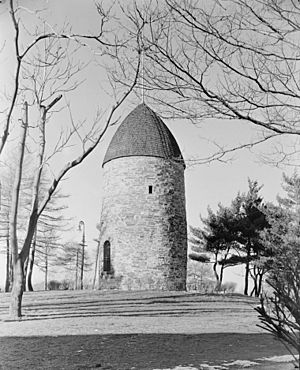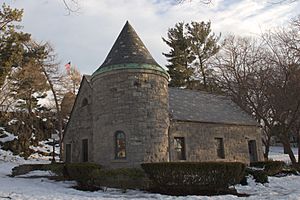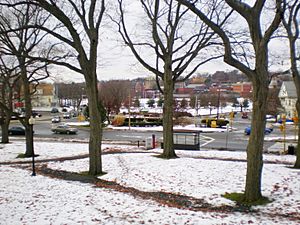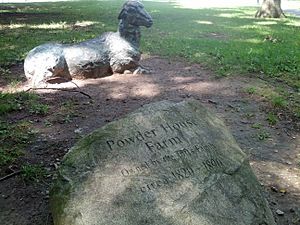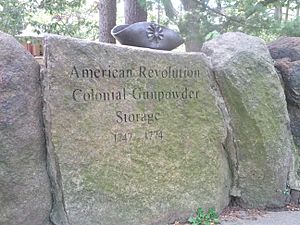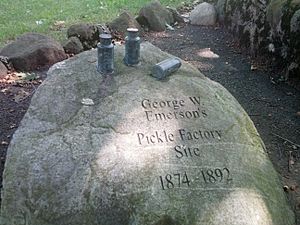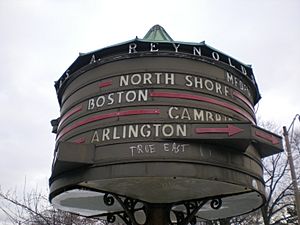Powder House Square facts for kids
Quick facts for kids |
|
|
Powder House Park
|
|
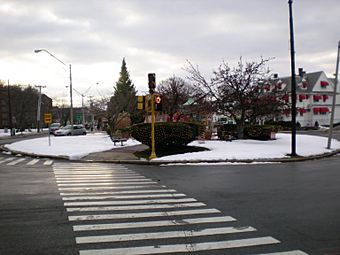
View of the Powder House Square rotary from Warner Street
|
|
| Location | Somerville, Massachusetts, United States |
|---|---|
| NRHP reference No. | 75000287 |
| Added to NRHP | May 21, 1975 |
Powder House Square is a well-known neighborhood and a large traffic circle in Somerville, Massachusetts. People sometimes call it Powder House Circle. It's a busy spot where six streets meet: College Avenue, Broadway, Warner Street, and Powder House Boulevard.
This square is right next to Tufts University's campus and borders Nathan Tufts Park. The name "Powder House Square" comes from a very old building called the Powder House. This building, which is from the 1700s, sits in Nathan Tufts Park and looks over the traffic circle.
Powder House Square was the site of an important event that helped start the American Revolutionary War. British soldiers secretly took gunpowder from the Powder House, which caused a huge reaction from the colonists. This event, known as the Powder Alarm, was a major step towards the war for independence.
Contents
A Look Back at History
Broadway was one of the first main roads in the area that is now Somerville. It was built in the 1600s. Back then, it was called "Menotomie's Road."
Powder House Boulevard was added in 1900. The traffic circle itself was named the James A. Reynolds Traffic Circle in 1940. This was to honor a professor from Tufts College.
The Old Powder House
The Old Powder House was first built around 1703 or 1704. It was used as a windmill by a man named John Mallet. In 1747, the government of Massachusetts bought it. They turned it into a place to store gunpowder. It is the oldest stone building in all of Massachusetts!
The Old Powder House was located where Broadway and College Avenue meet today. It held the largest supply of gunpowder in the colony. In 1774, General Thomas Gage became the military governor of Massachusetts. He was in charge of making sure the unpopular Intolerable Acts were followed. These laws were passed by the British Parliament after the Boston Tea Party. General Gage wanted to stop a war from starting. He thought the best way was to secretly remove military supplies from storage places in New England.
The Powder Alarm
Early on September 1, 1774, about 260 British soldiers secretly traveled up the Mystic River from Boston. They landed near Winter Hill. From there, they marched about a mile to the Powder House. After sunrise, they took all the gunpowder. Most of the soldiers then went back to Boston. A smaller group marched to Cambridge and took two cannons. The cannons and gunpowder were then moved to a British fort called Castle William.
When news of the raid spread, people thought a battle had happened. This caused a huge alarm across the countryside, even reaching Connecticut. American Patriots quickly got ready for action, fearing war was about to begin. Thousands of local soldiers, called militiamen, started heading towards Boston and Cambridge. Because of this, people loyal to Britain and some government officials had to flee to the British Army for safety.
This event was like a "dress rehearsal" for the Battles of Lexington and Concord seven months later. It made feelings on both sides even stronger. It also pushed both British and American forces to secure their gunpowder and cannons in safe places.
After the Revolutionary War
After the Revolutionary War, Massachusetts started storing gunpowder in other places. In 1818, the land with the Powder House was sold to Peter Tufts. This area became known as the Powder House Farm. The Tufts family used it as a farm and home for most of the 1800s. It later passed to Peter's heir, Nathan Tufts.
Interestingly, another Tufts family member, Charles Tufts, gave the land across Broadway to start Tufts College. This college, now Tufts University, was founded in 1852.
In the 1870s, a pickle maker named George Emerson started his business nearby. He stored his "Old Powder House Brand" pickles inside the Powder House. The building's two-foot-thick stone walls kept the pickles cool!
In 1890, the descendants of Nathan Tufts gave the Powder House Farm and the Powder House to the city. This led to the creation of Nathan Tufts Park in 1893.
The Field House in the park was built in 1935-1936. It used stones from an old train station that was torn down. This building has been used for many things over the years. It was an office for the Draft Board, then for the Traffic and Parking Department. More recently, it has been a Youth Program center. The building was repaired in 2001-2002 and can now be used by the public.
To celebrate its 100th birthday, the City of Somerville created a new city seal. This new seal features the Powder House.
Nathan Tufts Park and the Powder House were added to the National Register of Historic Places in 1975. This means they are recognized as important historical sites. The City of Somerville also made the park a local historic district in 1985.
In 1998, an accidental fire damaged the Powder House. It was then repaired and renovated in 2000-2001.
Powder House Square Today
Around Nathan Tufts Park, you can see small bronze sculptures. These sculptures show the park's past. They refer to it being a farm, a mill, a place for gunpowder storage, and even a pickle factory!
The island in the middle of the traffic circle is like a tiny park. It has walkways, benches, and pretty bushes. There's also a large sign that points to many different towns and cities nearby.
Powder House Square is very close to other squares in Somerville, like Davis Square, Teele Square, and Ball Square. You can get there by MBTA buses 80, 89, 94, and 96. The Red Line subway is also nearby at Davis Square Station. This makes it easy to get to Harvard Square and downtown Boston.
There are plans to add a light-rail station at Ball Square as part of the Green Line Extension project. This would make Powder House Square even easier to reach by public transport.
Many businesses are located in or around Powder House Square. These include restaurants, small medical and dental offices, and a funeral home.





